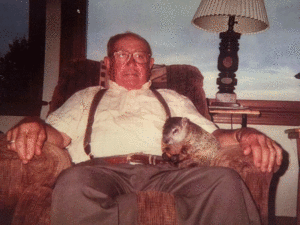
Skeeter the Goundhog, an Unlikely “Pet”
James Rada, Jr.
Having a groundhog as a pet wasn’t part of Harold Long’s plan when he took up the hobby of trapping groundhogs and selling them over ten years ago while working a dairy farm.
Trapping them has helped curb the damage that the groundhogs—considered rodents—can cause to farmland, crops, and farm equipment. It also serves to meet a demand for the consumption of the meat that is a common practice in some cultures.
“Some people came up from Montgomery County and asked if we had any groundhogs,” Long said. “I didn’t. I didn’t have time to be trapping them.”
The idea stayed with him, though, and when he retired from the dairy farm, he decided to start trapping groundhogs. He now has twenty-five traps in Thurmont, Woodsboro, and Walkersville, that he checks twice a day. Last year, Long caught three hundred sixty-one groundhogs.
He has eight clients to whom he sells the groundhogs. The customers travel to Thurmont from Montgomery County just to buy groundhogs. They will buy ten to twenty groundhogs at a time from Long.
His customers use groundhog meat in recipes. Their meat can be used in any recipe calling for small game, and in many other wild game recipes, too. Groundhogs are vegetarians and their meat is considered tender and tasty. However, groundhogs have a scent gland (as do rabbits and raccoons) that needs to be removed as soon as possible to keep from tainting the meat.
A side benefit of Long’s trapping is that gardens near the areas where Long places his traps are free from at least one invader. Harold Long was trapping groundhogs last year when he caught a nice-sized female that he thought his customers would like.
“I took her out, and three little ones came out of the hole after,” Long said. Long took pity on the cubs. They would have died without their mother. Young groundhog cubs are dependent on their mother for at least six weeks.
Long fed the cubs milk from a syringe and, when they got older, grass and ginger snaps. He kept them in a cage in the house. Two of the cubs eventually died, but the third one had a strong will to live and survived.
Long named him Skeeter, and he is now his “pet.” Skeeter sleeps in a cage when he’s in the house, but he is usually in the barn. Long built the groundhog a fort in the barn, where it could hibernate through the winter.
“He will stand on my leg and wait for me to pet him,” Long said. “I’m the only one he will go to. He’ll snap his teeth if anyone else gets close to him.”
Even when Skeeter is in the barn, he will come to Long because he knows that Long is the one who raised him and still feeds him.
Having a groundhog as a pet is not recommended in general. Though they appear cuddly and cute, they are wild animals and they will take action to protect themselves when they feel threatened.
 Harold Long and Skeeter the groundhog.
Courtesy Photo
Harold Long and Skeeter the groundhog.
Courtesy Photo
 Harold Long and Skeeter the groundhog.
Courtesy Photo
Harold Long and Skeeter the groundhog.
Courtesy Photo